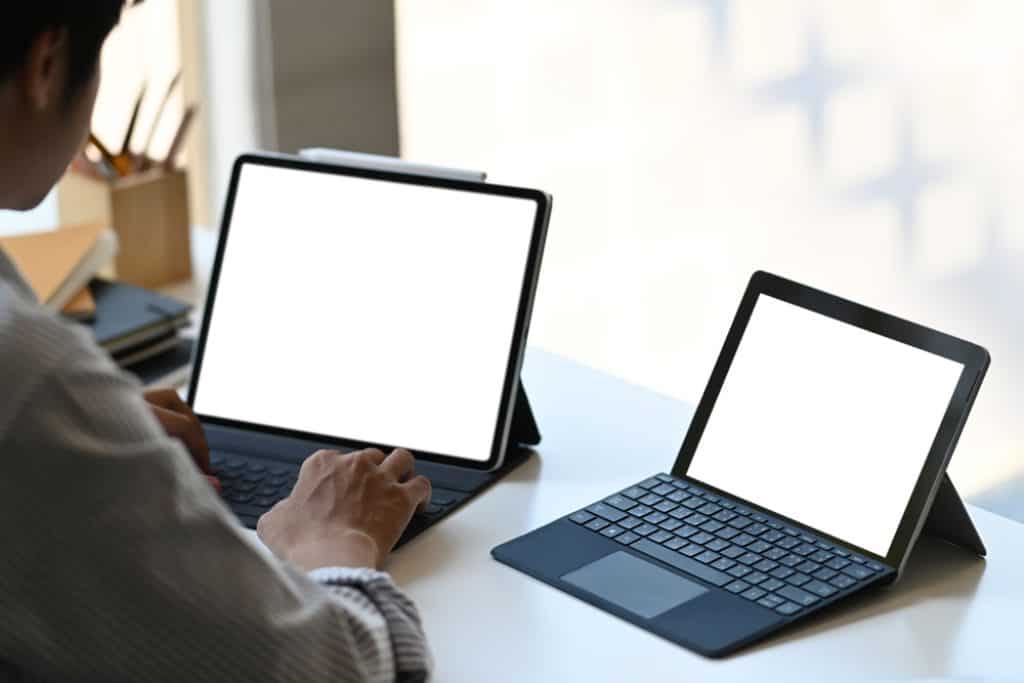For us to confidently provide an answer to the question, we have picked a laptop from the two lines of laptops for a close comparison. To be more specific, we picked the Microsoft Surface Laptop 4 15 Inch and the Microsoft Surface Pro 4. In case you are wondering, the basis of our comparison will span across various sections which will include the design and performance of the respective laptops. I’ll discuss how both laptops perform in terms of their CPU, RAM, GPU, storage, and battery life. In exchange for your time, you’ll get to discover which of the two Surface PCs will suit your needs, budget, and preference. Moreover, you will also get to find out which one our experts recommend.
Surface Laptop vs Surface Pro: My Initial Thoughts
Microsoft’s PC business has grown into a multinational corporation since the release of its Surface tablet in 2012. The Surface lineup has grown so wide that I’ve even lost track of the number of incredible high-end laptops they currently offer.
However, one thing I’m still certain of is that all Microsoft’s Surface notebooks and convertibles bring the Windows experience in its purest form to users. They all feature the company’s goal to deliver the standard Windows experience. Though the Surface line of laptops is very broad, the Surface Pro and the Surface Laptop are the two most popular models. This is the major reason why we’ve decided to center this comparison between both laptop lines. Besides, I’ve found myself constantly playing around with laptops in both the Surface Laptop and Pro line up in the past few weeks. So when I was asked to write an article comparing the two line-ups, I didn’t think twice before jumping on it. Join me as I share my experiences.
Surface Laptop vs Surface Pro: Design, Dimension & Weight Comparison
Before any major talks about their design, the first thing you need to know is that the Surface Laptop is a laptop just like your previous one probably was (if you had one already). “Of course I expect it to be a laptop” – that’s what you are probably thinking right? I promise you that I’m making sense here. While the Surface Laptop has the form of your regular laptop, the Surface Pro doesn’t. The Surface Pro is simply a tablet that can also be used as a regular laptop. With that said, the major difference between both laptops is their form factor. Asides from that, the family resemblance is entirely written on the design of both laptops. It is no surprise since they both come from the same parent line of laptop products. As I dive deeper into the review, you will discover the many similarities between both laptops’ designs. In the Microsoft Surface extended family, the Surface Laptop line is like the odd nuclear family. Unlike Microsoft’s other Surface line ups, the Surface Laptop has always been the most boring and simplest lineup. At first, the Microsoft Surface brand was mainly about tablets until the Surface Laptops arrived at the party. The Surface Laptop doesn’t have a screen that can detach or rotate, but it still has that stylish and simple design common to Surface devices. It has an appealing anodized aluminum finish that you can get in either platinum, cobalt blue, graphite gold, burgundy, or even black. Our review unit came with the black color. I’ll admit, the black finish does the job for me. The Surface Laptop’s black finish gives it a daring and eye-catching look that will make anyone want to see more of the laptop. It may look like a regular black laptop from afar, but I promise you that you will be smitten by the richness of the laptop’s black color when you move closer. The beautiful thing is that Microsoft gave enough room for the Surface Laptop’s rich black color to show its depth on the laptop’s lid. There’s no other pattern on the Surface Laptop’s lid aside from the Microsoft logo. This silver logo has a reflective finish that perfectly complements the laptop’s black paint. Similarly, the Surface Pro’s metallic-grey magnesium finish barely features any design pattern. Like the Surface Laptop, the only design pattern on the Surface Pro’s body is the reflective Microsoft silver logo. To be precise, this logo is etched onto the kickstand on the lower part of the laptop’s lid. This kickstand is one of the major features that aid the functionality of the Surface Pro. It helps to sturdily hold the tablet’s display in place when you are using it in laptop mode. The kickstand’s hinge is solid enough to help you get the most comfortable position for the display. In fact, the entire laptop’s body feels incredibly solid despite the flexibility in its build. Likewise, the Surface Laptop’s chassis is very solid. Its thin and light form makes its sturdiness even more impressive. The Surface Laptop measures 339.5 x 244 x 14.7 mm and weighs just 1542 g. However, the Surface Pro is much more compact, thinner, and lighter. To be specific, the Surface Pro measures 292 x 201 x 8.45 mm. The laptop’s weight may differ depending on the processor configuration it comes with. When it is equipped with the Intel Core i5 and i7 processor the Surface Pro weighs 786 g. With the Intel Core m3 processor, the Surface Pro is 766 g light. Anyone will applaud the level of sturdiness in both laptops’ build. However, the Surface Pro may move around a bit when you try to open it up with one finger. The Surface Laptop, on the other hand, will sit firmly on the table. When you get to the interior parts of both laptops, you will notice that both laptops have the same 3:2 screen aspect ratio. Another similar thing is the smoothly curved edges surrounding both laptops’ displays. They do share another similar thing. However, I’m not so happy to talk about this one. Maybe I’ve been spoiled with the ultra-thin bezels on laptops like the Dell XPS 15, but I just can’t hide my extreme displeasure for the bezels on these Surface devices. I can still pardon the Surface Pro because it also functions as a tablet, but the Surface Laptop is inexcusable. I would really love to see thinner bezels on both laptops. As if Microsoft anticipated that some may dislike the thick bezels, they did well to equip both laptops with fantastic displays. Both laptops’ displays also have touch screen features. The Surface Pro comes with a smaller, 12.3-inch 2736 x 1827 resolution display. Meanwhile, the Surface Laptop features a 15-inch display with a 2496 x 1664 screen resolution. Below both laptops’ displays, there’s another big difference. Although both laptops feature Microsoft’s Alcantara fabric on their keyboards, I wouldn’t call what is below the Surface Pro’s display a “regular keyboard”. Even Microsoft themselves don’t call it a regular keyboard. While the Surface Laptop has a regular built-in keyboard, the Surface Pro uses an optional Surface Type Cover as its keyboard. For the most part, this Surface Type Cover is another feature that largely contributes to the Surface Pro’s versatility. The Surface Type Cover attaches to the Surface Pro’s display via a magnetic strip. Attaching and detaching the Surface Pro’s Type cover from the display is a smooth and effortless process thanks to this technology. If you want to enjoy the complete functionality of the Surface Pro’s design, I will recommend you to get the Surface Type Cover. The Surface Pro experience is not complete without the Surface Type Cover. Although the Type Cover doesn’t offer the same typing experience you will get on a real keyboard, it is quite satisfactory. With its chiclet-style layout, the Type Cover is spaced well enough to offer a comfortable typing experience. Its 1.4 mm key travel is also a brilliant feature that enhances the typing experience on the Type Cover. Add its backlighting feature, and I can boldly say the Type Cover sold with the Surface Pro is the best I’ve come across on any Surface device. Moving on to the Surface laptop, the keyboard on the Surface Laptop also offers an incredible typing experience. It is equally spacious and each of its keys has a good key travel of 1.4 mm too. Like the Surface Pro’s Type Cover, the Surface Laptop’s keyboard has a backlighting feature that makes the keyboard even more lovable. The icing on the cake is the Alcantara fabric on the palm rest area. Your wrist will move gracefully on the perfect soft-touch Alcantara fabric on the keyboard. This Alcantara fabric is also on the Surface Pro’s Type Cover. The disadvantage with the Alcantara fabric is that it can get messy if stained. You will need to take proper care to avoid staining this fabric too often unless you can spend extra cash to buy the stain-resistant type. Below both laptops’ keyboards, you get large glass touchpads. The touchpads on both laptops are smooth and reliable. You will totally enjoy tapping, scrolling, and performing Windows 10 gestures on both laptops’ touchpads. In terms of ports, neither of the two laptops impress in this department. They both feature very limited options for port connections. The Surface Laptop features just 1 USB Type C and 1 USB Type-A port. Meanwhile, the Surface Pro comes with a magnetic charging port, one USB 3.0 port, and a mini DisplayPort on its right side. On the left side of the laptop, there’s a headphone/mic jack. You also find a microSD card reader hidden behind the kickstand in the back. Ultimately, choosing between the Surface Laptop and Pro in terms of design depends largely on preference. Both laptops have a solid build quality and an equally exquisite design. If you are not a fan of Microsoft’s “Surface tablets can replace your laptop” claim, the Surface Laptop’s design will sit perfectly well with you. However, if you are sold on the versatility idea, the Surface Pro’s design will be the ideal one for you. While the Surface Pro takes a huge point because of the functionality of its design, the Surface Laptop hits back with its sturdier build. If we take a closer look at many other design features, both laptops counterbalance each other with different features that will appeal to their target users. As a result, both the Surface Laptop and the Surface Pro score an eight in this Surface Laptop vs Surface Pro design comparison.
Surface Laptop vs Surface Pro Processor (CPU) Performance Comparison
Both the Surface Laptop and Surface Pro entertain their potential buyers with a range of processor configuration options. While the Surface Laptop offers two processor configurations, the Surface Pro offers three. When you want to buy the Surface Laptop, you can either equip the laptop with the quad-core Intel Core i7-1185G7 processor or the eight-core AMD Ryzen 7 4980U processor. The Intel Core i7-1185G7 processor runs at a base frequency of 3.0 GHz and it can attain a maximum frequency of 4.80 GHz. Meanwhile, the AMD Ryzen 7 4980U processor has a base frequency of 2.0 GHz and a boost frequency of 4.40 GHz. In the case of the Surface Pro, Microsoft offers either a dual-core Intel Core m3-6Y30 processor or a dual-core Intel Core i5-6300U processor. There’s also an option for you to buy a laptop with a dual-core Intel Core i7-6650U processor. For more information, the Intel Core m3-6Y30 processor has a base frequency of 900 MHz and a boost frequency of 2.20 GHz. The Intel Core i5-6300U processor has a base frequency of 2.40 GHz and a boost frequency of 3.00 GHz. Lastly, the Intel Core i7-6650U processor offers a base frequency of 2.20 GHz and a boost frequency of 3.40 GHz. Of all the processor configurations available for both laptops, our Surface Laptop review unit came with the AMD Ryzen 7 4980U processor. Meanwhile, our Surface Pro unit features the Intel Core i5-6300U processor. In use, both laptops’ processors are extremely capable. You won’t have any difficulty carrying out your regular computing tasks on either of the two laptops. Tasks like web browsing, document preparation, and sending of emails, will all be swift on both the Surface Pro and Surface Laptop. I also ensured to keep a record of how both laptops performed on a benchmark performance test – the Cinebench R15 benchmark, to be precise. Maxon’s Cinebench benchmark tests a laptop’s CPU by making use of all of its available cores and thread to render a 3D image as quickly as possible. Instead of the GPU, Cinebench stresses the CPU to render the image. The result is a score that indicates the laptop’s suitability for processor-intensive workloads – the higher the better. It is worth mentioning that this benchmark test offers two types of results – single and multi-core test scores. In the single-core aspect of this test, the Surface Laptop got a score of 182 points, while the Surface Pro scored 132 points. The margin between the Surface Laptop and Surface Pro’s score became wider in the multi-core aspect. While the Surface Pro scored 342 points, the Surface Laptop blasted to a score of 1658 points. On a Handbrake video encoding test that required both laptops to convert a 12-minute 4K video to 1080p, the Surface Laptop performed better again. In case you are wondering what the Handbrake test is about, Handbrake is a popular open-source video conversion software. In this test, professionals test how fast laptops can convert a type of video format into another. As I hinted earlier, the Surface Laptop completed this test within a faster time frame compared to the Surface Pro. It took the Surface Laptop 7 minutes to complete this test. The Surface Pro, on the other hand, needed 12 minutes to complete the test. Overall, the significant difference in both laptops’ performance is easily noticeable in every aspect of the benchmark tests. This makes the Surface Laptop the indisputable champion in this round. Hence, the Surface Laptop scores an eight in this Surface Laptop vs Surface Pro processor comparison. Meanwhile, the Surface Pro scores a six.
Surface Laptop vs Surface Pro Memory (RAM) Performance Comparison
Despite having only one memory slot, the Surface Laptop allows easy upgrade of its RAM. The laptop usually comes with an initial 8 GB LPDDR4X RAM that can be upgraded to a maximum capacity of 32 GB. Meanwhile, you can equip your Surface Pro with either 4 GB, 8GB, or 16 GB LPDDR3 RAM. It has only one RAM slot too but you cannot upgrade its RAM. This is because it has a non-removable RAM slot. Think carefully before you buy this laptop with any of the above-stated RAM configurations for the Surface Pro because you can’t upgrade the tablet’s RAM after purchasing it. Ask yourself if you will be carrying out memory-intensive tasks. If you are a graphics designer, an artist, or a video editor, then you should buy the laptop with the biggest RAM configuration available. Regardless of the RAM configuration, the Surface Pro should hold up well with at least 8 GB RAM. At least, that’s what the benchmark and real-world performance tests suggested. You will not encounter any performance issues if you decide to stream up to three YouTube videos with about 18 Google Chrome tabs open. If you decide to further test the laptop’s strength with a few local running apps, the laptop will still not flinch or slow down. Similarly, the 16 GB RAM our Surface Laptop unit came with proved to be an excellent configuration. The Surface Laptop also handles a good number of simultaneous operations with relative ease. To give you an example of what the laptop can handle, try running about 20 Google Chrome tabs while listening to music on Spotify. You can even run more operations and you won’t notice any lags or hiccups on the Surface Laptop. Of course, if you overload the laptop beyond a reasonable workload limit, it will show signs of being stressed. The same condition applies to the Surface Pro. In fact, the Surface Pro is likely to show distress signs quicker than the Surface Laptop. When I proceeded to gather the memory performance results of both the Surface Laptop and Surface Pro, I was impressed with what I came across. Our Surface Laptop and Surface Pro test units performed well in the PCMark benchmark tests. In case you are not familiar with the benchmark, the PCMark benchmark helps testers to replicate various real-world productivity and content-creation operations. Hence, the benchmark is useful for evaluating a laptop’s overall system performance for various computing tasks. The PCMark benchmark operates by simulating office-related tasks like word processing, web surfing, spreadsheet document preparation, and videoconferencing. At the end of the test, it gives the laptop a score based on its performance. The higher the score, the better. I was able to get a record of how the Surface Laptop performed in the PCMark 10 version. Unfortunately, I couldn’t get a record of how the Surface Pro performed on the same PCMark 10 version. Instead, I was only able to get the performance record of the Surface Pro in the PCMark 8 version. Even though we can’t carry out a direct comparison, we can still find out how well both laptops’ RAM can perform. Since the Surface Laptop’s test record is on the higher version, I expected the Surface Pro to get a better score on its lower version test. The reverse turned out to be the case here. On the PCMark 8 test, the Surface Pro scored 4431 points. Meanwhile, the Surface Laptop that took the higher PCMark 10 version test had a better score of 5154 points. In almost every aspect that concerns their memory, the Surface Laptop offers something better than the Surface Pro. For instance, the Surface Laptop’s memory can be upgraded to a maximum capacity of 32 GB but the Surface Pro allows a maximum of 16 GB. In addition, we have reasonable facts to conclude that the Surface Laptop can offer a better memory performance than the Surface Pro. Due to these reasons, we’ve decided that the Surface Laptop wins in this aspect of the comparison. The Surface Laptop scores an eight in this Surface Laptop vs Surface Pro memory performance comparison. Meanwhile, the Surface Pro scores a seven.
Surface Laptop vs Surface Pro Storage Options & Performance Comparison
The storage configuration of both the Surface Laptop and Surface Pro is nearly the same. Both laptops feature 1 TB SSDs. What differentiates both laptops’ storage options is the microSD card reader the Surface Pro offers for external storage expansion. On the other hand, the Surface Laptop doesn’t have an SD card storage option. Even though these two laptops feature the same storage configurations, their speeds differ. Their CrystalDiskMark benchmark results back up this claim. On the CrystalDiskMark test, the Surface Pro recorded a sequential read speed of 928 MBps and a sequential write speed of 449MB/s. Meanwhile, the Surface Laptop offered sequential read and write speeds of 1007.82 MBps and 851.07 respectively. The Surface Pro has a transfer speed of 318.1 MBps. With this transfer speed, it can copy a 4.97 GB file in 16 seconds. Meanwhile, the Surface Laptop has a better transfer rate of 372.49. This means it can copy the same 4.97 GB file within a shorter time – 13 seconds, to be precise. Once again, the Surface Laptop finishes another round of comparison with a win. After all, it outperformed the Surface Pro in every aspect of the storage performance test. As a result, it scores a nine in this Surface Laptop vs Surface Pro storage performance comparison. The Surface Pro, on the other hand, scores an eight for its good storage option and relatively fast storage speed.
Surface Laptop vs Surface Pro Graphics Card Performance Comparison
In terms of their graphics card, Microsoft offers a set of configuration options for both laptops. You can buy the Surface Laptop 4 with either an integrated Intel Iris Xe Graphics card or an integrated AMD Radeon Graphics card. Unfortunately, neither of these GPU configuration options comes with a dedicated VRAM. In terms of their speeds, the Intel Iris Xe Graphics card has a base frequency of 300 MHz and a boost frequency of 1350 MHz. The AMD Radeon Graphics card also offers a base frequency of 300 MHz, but a faster boost frequency of 1750 MHz. For the Surface Pro, you can buy the laptop with either one of three different integrated Intel graphics card options. The Surface Pro can feature an Intel HD graphics 515 card, an Intel HD graphics 520 card, or an Intel Iris Graphics 540 card. Like the Surface Laptop’s graphics card options, none of the Surface Pro’s graphics card options is sold with dedicated VRAM. If you care to know, the Intel HD graphics 515 card has a base frequency of 300 MHz and a boost frequency of 850 MHz. The Intel HD graphics 520 card also has a base frequency of 300 MHz, but it has a boost frequency of 1000 MHz. Lastly, the Intel Iris Graphics 540 card follows suit with the 300 MHz base frequency of the other configuration options. However, it has the fastest boost frequency amongst all. It has a boost frequency of 1050 MHz. For the performance test, I decided to take a look at how both laptops performed in a 3DMark 11 GPU performance test. 3DMark 11 is a video card benchmark test tool that measures the gaming capabilities of a laptop. The benchmark usually tests a laptop’s gaming capabilities by subjecting it to game-like loads. At the end of the test, it rates the laptop’s performance with a definite score – higher scores mean better performance. On this test, the Surface Laptop outperformed the Surface Pro by a long range. The Surface Pro scored 2624 points, while the Surface Laptop scored 6440 points. Apart from the benchmark performance test, I also looked out for both laptops’ real-world gaming performance results. The Surface Laptop can play The Witcher at 70.6 fps. Meanwhile, the Surface Pro offers frame rates of 46.8 fps when running the game. When the Surface Laptop ran X-Plane 11.11, it was able to offer frame rates of 40.4 fps. The Surface Pro, on the other hand, barely played the game at 23.5 fps. In conclusion, it is clear that the Surface Laptop wins in this graphics performance comparison. It outperformed the Surface Pro in both the real-world and benchmark performance test. Hence, the Surface Laptop scores an eight in this Surface Laptop vs Surface Pro graphics card performance comparison. The Surface Pro, on the other hand, scores a six.
Surface Laptop vs Surface Pro Battery Life & Performance Comparison
While the Surface Laptop features a 45.8 Wh Lithium-ion battery, the Surface Pro is equipped with a 38.2 Wh Lithium-ion battery. Microsoft promised battery life of 17.5 hours when it was advertising the Surface Laptop. They also promised that the Surface Pro will offer up to 9 hours of battery life. I’m not the type of person to take manufacturers’ words for it when it comes to battery life. After all, they are trying to make sales. Their cause will be justified if they sugarcoat the efficiency of their product’s performance. To give you a more objective report on how long these laptops last, I’ve carried out my research. On our continuous web surfing test, the Surface Laptop lasted up to 10 hours 24 minutes under medium screen brightness. The Surface Pro, on the other hand, lasted 4 hours and 53 minutes on the same test. On an increased computing-related workload, the Surface Laptop couldn’t last longer than 2 hours and 30 minutes. Meanwhile, the Surface Pro ran out of power after 1 hour and 20 minutes had passed. Evidently, the Surface Laptop has a longer battery life compared to the Surface Pro. The test results show the difference in their battery runtime. Hence, the Surface Laptop scores an eight in this Surface Laptop vs Surface Pro battery performance comparison. Meanwhile, the Surface Pro scores a six.
Surface Laptop vs Surface Pro: Our Rating Summary
Surface Laptop vs Surface Pro: My Final Thoughts
At first, picking between the Surface Laptop and Surface Pro can be dependent on your choice for a laptop or tablet. However, it is important for you to know that aside from its versatility, there’s nothing spectacular about the Surface Pro. It can barely stand beside the Surface Laptop in terms of performance. The only other thing that could make you consider it over the Surface Laptop is if you are on a budget. Compared to the Surface Laptop, the Surface Pro is very affordable. Regardless, the Surface Laptop is worth every penny. It has a better overall performance and a longer battery life compared to the Surface Pro. If you need a laptop that will conveniently handle all your intensive computer-related operations, you can rely on the Surface Laptop. Hence, based on our comprehensive comparison of the Surface Laptop vs Surface Pro, we recommend: However, if you want to spend less, you can consider the Surface Pro. If you found the review helpful, kindly spare few minutes to share your thoughts with Itechguides Community Forum. You could review this product with our community members at Itechguides Community Forum.
References And Further Reading















